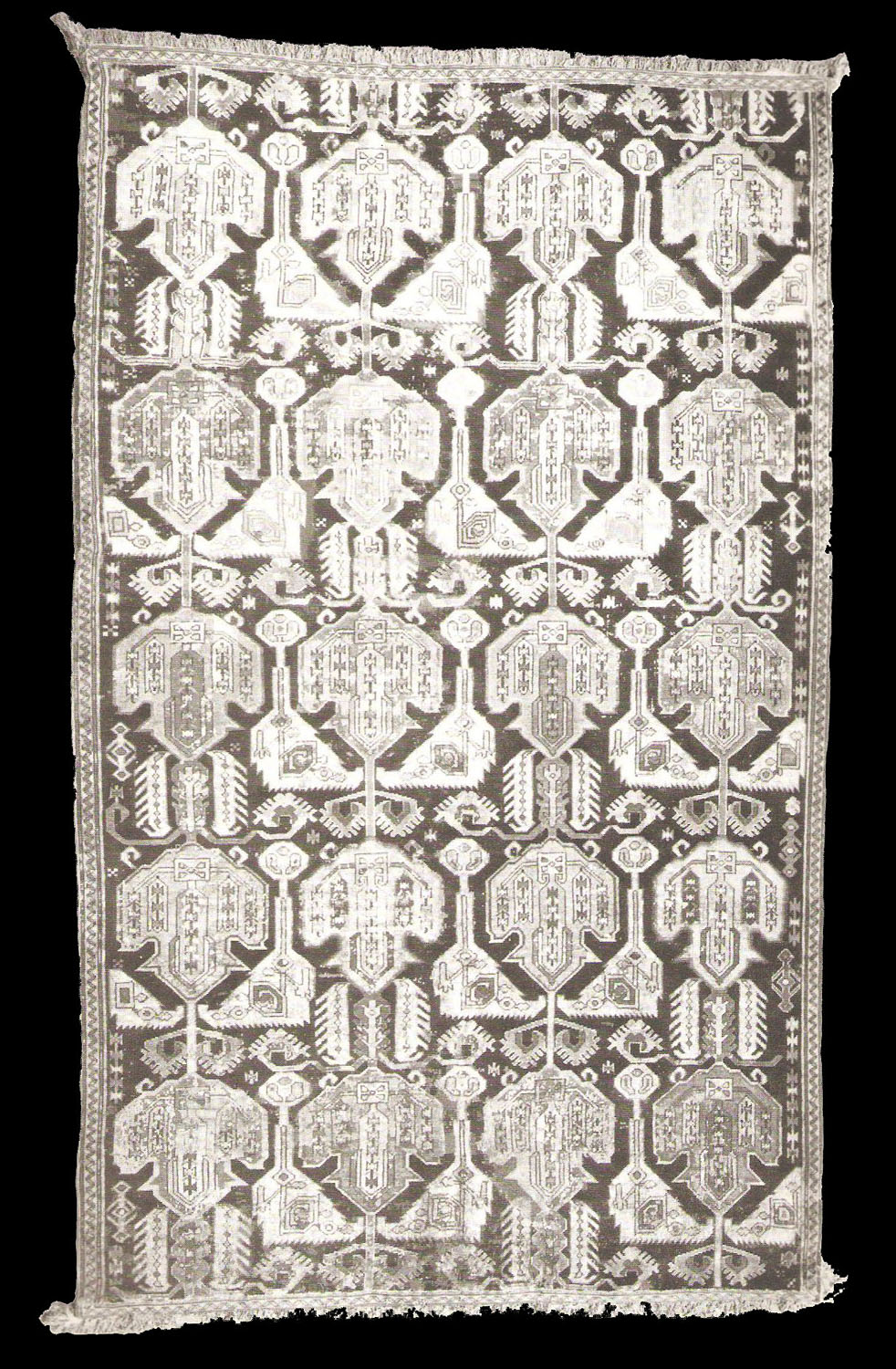|
Rug with palmettes
in a brocade pattern. Shirvan, Possibly Shamakhi, Azerbaijan, early 19th
century. Textile Museum R 36.2.10.
Published Charles Grant Ellis "Early Caucasian rugs" plate 34
|
|
Rug with Palmettes in a Brocade Pattern. Shirvan, Shemakha Area? 19th
Century. Textile Museum R 36.2.10 (formerly R 2.7).
This rug has evidently been reduced at both ends so that its format is now
more limited than Plate 33, which shows the same field pattern. The clasping
lancet leaf—"trees" in pairs are less jagged in outline than those in Plate
33 and in the Athens and Deerfield rugs that are mentioned in its
description. The field is dark blue. The palmettes still alternate two
colors within the row, but in a vertical alternation of three schemes. Those
in the upper row are brick red or dull green; the second row yellow or
beige; the third row light medium blue or dull orange. The fourth row
repeats the coloring of the first; the present bottom row repeats the
second. The "trees" are ivory. The tiny extraneous forms appear, as usual,
along the sides of the field. The inner guard stripe alone survives at the
sides as a zigzag ribbon.
The zigzag occurs in the guard stripes of a rug in this design which belongs
to Vojtech Blau in New York and in another which has been in the hands of
Ulrich Schurmann in Cologne. Both have the same border stripe as Plate 27,
in a slightly simplified version, and so does Metropolitan Museum of Art
22.100.118 from the Ballard Collection (Dimand & Mailey 1973: Fig. 230) and
a rug which once belonged to Badih Bulos in Beirut (Seyrig et al 1963: PI.
43). It seems probable that Plate 34 had a border in the same pattern,
although in a fragment at Hannover (Kestner Museum 5475, H. Erdmann 1966:
No. 18) the zigzag-accompanies an exceptional border stripe.
A second Kestner Museum fragment at Hannover, No. 5427 (H. Erdmann 1966: No.
19), has an ivory ground. The same techniques of weaving and probably the
same origin are shared by several rugs which differ widely in appearance. A
rug in the Metropolitan Museum of Art, 30.95.146 (Valentiner 1910: No. 14),
marshals degenerated palmette forms in rows beneath the familiar lancet
leaves upon a ground of red. In the McMullan Collection (McMullan 1965:P1.
48) a blue-green field held rows of octagons within a border of Yomud curls.
The battered remnants of a similar rug survive in the Ulu Cami at Divrik in
Turkey.
A carpet with blue ground in the Siesta Collection in Milan offers a bizarre
arrangement of Herat-type palmettes, lancet leaves like fringed
caterpillars, and reminiscences of the octagram stars in the rug in the
Musee des Arts Decoratifs in Paris. A pattern in which palmettes are
alternated with bracket-like forked arabesques occurs in rugs in the
Gul-benkian Foundation, Lisbon, T.81, and the Erickson Collection at the
Brooklyn Museum, L 63.9.59. There is a fragment of yet another in the
storage of the Paris museum, No. 40432. In England Miss Godman has a small
example with a wild spray of flowers and leaves towards each end. There has
even been a strangely drafted dragon rug design, seen in an extremely
attractive carpet in the McMullan Collection, now property of the
Metropolitan Museum (McMullan 1965: PL 39).
Size: As reduced: L. 2.21 m. (7'3") x W. 1.35 m. (4'5").
Warp: Z3S. Two strands are ivory cotton, the third is silk which may be
ivory or dyed pink or beige. One level.
Weft: Z2.S silk dyed pink or flesh or flame, or a combination: one strand
may be ivory or pink silk and the other strand ivory cotton. Two shots.
Pile: 2Z wool. Gordes knotted, pile lies straight. 9 1/2 horiz. x 11 vert.
per in. (105 per sq.in.).
Sides: Cut. Ends: Cut.
Colors: Ivory; black-brown; dull orange; beige (probably a faded color);
yellow; brick red; dark and light medium blues; dull green.
Condition: Ends of field reduced; border missing except for inner guard
stripes at sides; very worn; heavily re-knotted in colors now faded.
Unsuitable for showing.
Unpublished.
 |

